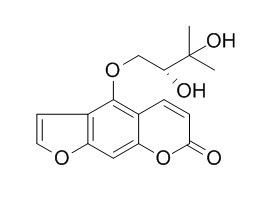Oxypeucedanin hydrate
Oxypeucedanin hydrate is an antimutagenic agent, it has antioxidant activity, and exhibits carbohydrate metabolizing enzymes inhibitory effect.
Inquire / Order:
manager@chemfaces.com
Technical Inquiries:
service@chemfaces.com
Tel:
+86-27-84237783
Fax:
+86-27-84254680
Address:
1 Building, No. 83, CheCheng Rd., Wuhan Economic and Technological Development Zone, Wuhan, Hubei 430056, PRC
Providing storage is as stated on the product vial and the vial is kept tightly sealed, the product can be stored for up to
24 months(2-8C).
Wherever possible, you should prepare and use solutions on the same day. However, if you need to make up stock solutions in advance, we recommend that you store the solution as aliquots in tightly sealed vials at -20C. Generally, these will be useable for up to two weeks. Before use, and prior to opening the vial we recommend that you allow your product to equilibrate to room temperature for at least 1 hour.
Need more advice on solubility, usage and handling? Please email to: service@chemfaces.com
The packaging of the product may have turned upside down during transportation, resulting in the natural compounds adhering to the neck or cap of the vial. take the vial out of its packaging and gently shake to let the compounds fall to the bottom of the vial. for liquid products, centrifuge at 200-500 RPM to gather the liquid at the bottom of the vial. try to avoid loss or contamination during handling.
Translational Neuroscience2024, 15:20220339
Molecules.2023, 28(3):1313.
Int J Mol Sci.2018, 19(9):E2601
Food Chemistry: X2023, 101032.
Methods Protoc.2024, 7(6):95.
Protoplasma.2024, 261(6):1267-1280.
Molecular Simulation2023, 49(8):799-815.
Molecules.2021, 26(2):313.
International J of Green Pharmacy2019, 13(3)
Heinrich Heine University Dusseldorf2021, 62203.
Related and Featured Products
J Chromatogr B Biomed Sci Appl. 2001 Apr 5;753(2):309-14.
Simultaneous determination of byak-angelicin and oxypeucedanin hydrate in rat plasma by column-switching high-performance liquid chromatography with ultraviolet detection.[Pubmed:
11334345]
METHODS AND RESULTS:
A simple and sensitive column-switching HPLC method was developed for the simultaneous determination of two furocoumarin compounds, byak-angelicin and Oxypeucedanin hydrate, which are the main components of hot water extract of Angelica dahurica root (AE), in rat plasma. Plasma sample was simply deproteinated with perchloric acid. After centrifugation, the supernatant was injected into a column-switching HPLC system consisting of a clean-up column (Symmetry Shield RP 8, 20x3.9 mm I.D.) and analytical column (Symmetry C18, 75x4.6 mm I.D.) which were connected with a six-port switching valve. The flow-rate of the mobile phase (acetonitrile-water, 20:80) was maintained at 1 ml/min. Detection was carried out at wavelength 260 nm with a UV detector. The column temperature was maintained at 40 degrees C. The calibration curves of byak-angelicin and Oxypeucedanin hydrate were linear over the ranges 19.6 to 980 ng/ml (r2>0.997). The accuracy of these analytes was less than 4.4%. The intra- and inter-day relative standard deviations of byak-angelicin and Oxypeucedanin hydrate were within 12.0% and 12.7%, respectively.
CONCLUSIONS:
The present method was applied for the analysis of plasma concentration from rats after administration of AE.
Pharm Biol . 2018 Dec;56(1):658-664.
Antiproliferative and cytotoxic activities of furocoumarins of Ducrosia anethifolia[Pubmed:
31070540]
Abstract
Context: Phytochemical and pharmacological data on Ducrosia anethifolia (DC.) Boiss. (Apiaceae), an Iranian medicinal plant, are scarce; however, furocoumarins are characteristic compounds of D. anethifolia.
Objective: Our experiments identify the secondary metabolites of D. anethifolia and assess their antitumor and anti-multidrug resistance activities.
Materials and methods: Pure compounds were isolated from the extract of aerial parts of the plant by chromatographic methods. Bioactivities were tested on multidrug resistant and sensitive mouse T-lymphoma cell lines. The inhibition of the cancer MDR efflux pump ABCB1 was evaluated by flow cytometry (at 2 and 20 μM). A checkerboard microplate method was applied to study the interactions of furocoumarins and doxorubicin. Toxicity was studied using normal murine NIH/3T3 fibroblasts.
Results: Thirteen pure compounds were isolated, nine furocoumarins namely, pabulenol (1), (+)-Oxypeucedanin hydrate (2), oxypeucedanin (3), oxypeucedanin methanolate (4), (-)-Oxypeucedanin hydrate (5), imperatorin (6), isogospherol (7), heraclenin (8), heraclenol (9), along with vanillic aldehyde (10), harmine (11), 3-hydroxy-α-ionone (12) and 2-C-methyl-erythrytol (13). Oxypeucedanin showed the highest in vitro antiproliferative and cytotoxic activity against parent (IC50 = 25.98 ± 1.27, 40.33 ± 0.63 μM) and multidrug resistant cells (IC50 = 28.89 ± 0.73, 66.68 ± 0.00 μM), respectively, and exhibited slight toxicity on normal murine fibroblasts (IC50 = 57.18 ± 3.91 μM).
Discussion and conclusions: Compounds 2, 3, 5, 7, 10-13 were identified for the first time from the Ducrosia genus. Here, we report a comprehensive in vitro assessment of the antitumor activities of D. anethifolia furocoumarins. Oxypeucedanin is a promising compound for further investigations for its anticancer effects.
Keywords: ABCB1; Multidrug resistance; PAR; aviprin; prangol; checkerboard assay.
Biomed Res Int. 2014;2014:480545.
Preliminary in vitro and in vivo evaluation of antidiabetic activity of Ducrosia anethifolia Boiss. and its linear furanocoumarins.[Pubmed:
24800231]
Ducrosia anethifolia is used as flavoring additive. There have been little detailed phytochemical reports on this genus and the antidiabetic activity of this plant is not yet evaluated.
METHODS AND RESULTS:
Structure of compounds was deduced by spectroscopic analyses. Preliminary in vitro evaluation of the antidiabetic activity of crude extract and its furanocoumarins was carried out ( α -amylase, α -glucosidase, and β -galactosidase). The in vivo activity was investigated by measuring some oxidative stress markers. Biomarkers of liver injury and kidney were also determined.
Eight linear furanocoumarins, psoralen, 5-methoxypsoralen, 8-methoxypsoralen, imperatorin, isooxypeucedanin, pabulenol, oxypeucedanin methanolate, Oxypeucedanin hydrate, and 3-O-glucopyranosyl- β -sitosterol, were isolated. All compounds were reported for the first time from the genus Ducrosia except pabulenol. The blood glucose level, liver function enzymes, total protein, lipid, and cholesterol levels were significantly normalized by extract treatment. The antioxidant markers, glucolytic, and gluconeogenic enzymes were significantly ameliorated and the elevated level of kidney biomarkers in the diabetic groups was restored. The compounds showed inhibitory activity in a concentration dependant manner. Imperatorin and 5-methoxypsoralen showed the most potent inhibiting power.
CONCLUSIONS:
D. anethifolia extract showed hypoglycemic, hypolipidemic, and antioxidant effect as well as ameliorating kidney function. This extract and some linear furanocoumarins exhibited carbohydrate metabolizing enzymes inhibitory effect.



